There’s something endearing about the story of a mom-and-pop business rising to international acclaim, especially when that business was dedicated to quality craftsmanship—even when that business has changed over the last 130 years.
Table of Contents
Roamer Watch History. From humble and earnest beginnings…
Between the banks of the aquamarine Aare river and the Jura mountains, the picturesque town of Solothurn (Soleure in French) was where Fritz Meyer assembled a small team of six employees to make cylinder escapements in 1888.
Within less than a decade, Meyer’s company was no longer producing parts, but assembling complete watches. In other words, Meyer became an établisseur, a watchmaker buying movements and parts and assembling them. The number of employees had increased tenfold, and by 1897 they developed the company’s very first caliber—naming it “38” in honor of Meyer’s 38th birthday.
Taking the world (fairs) by storm
In 1905 Meyer teamed up with fellow watchmaker Johann Studeli to create a partnership, MST (Meyer and Studeli). They entered their collaborative watchmaking efforts into various World Fairs, winning accolades in Liege, Milan, and Brussels.
Just three years later, the company had grown to 300 employees, with Meyer and Studeli at the helm, and their reputation for precision and reliability had expanded beyond Swiss borders, with almost two dozen registered watch lines.
The First World War did not slow down the onward march of this ambitious watchmaking duo. Around 1917, they purchased another watchmaking company in Solothurn, L. Tièche-Gammeter (LTG).
The two companies had already collaborated off and on throughout the previous decades, and it was an LTG line—Roamer—that would become the registered, trademarked brand name and face of the company moving forward (it had already been registered in 1908-1909 by LTG).
In fact, one of the most intriguing chapters in the history or Roamer are the early years of the company, while they were still under the name Meyer and Studeli (MST), and before they merged with LTG. As mentioned, it was actually LTG who had first come up with the name ROAMER (though you won’t find that so clearly spelled out on the official Roamer website and information on this subject is scarce and sometimes contradictory).
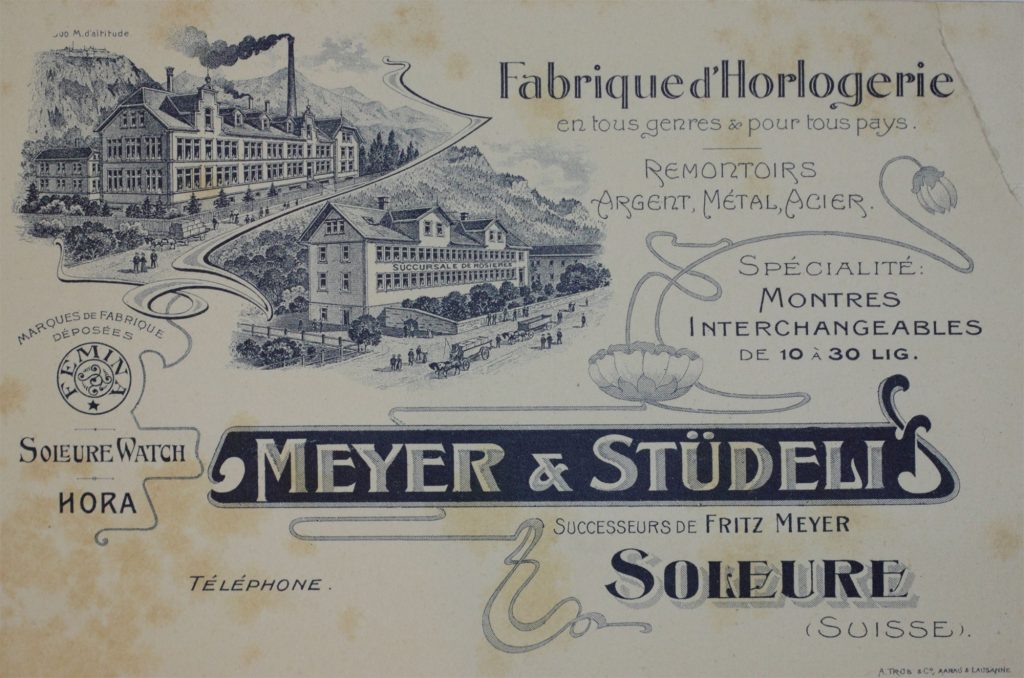
Watches from these years (that is, until 1917) can sometimes be found on various marketplaces, but there is much confusion about which company made which watch—though advertisements from the era show extensive collaboration between the two brands. In fact, the first watches under the brand Roamer can be traced back to around 1918.
If you want something done right…
During the 20s and through the 50s, Roamer positioned itself to live by the famous creed that if you want something done right, do it yourself. Though they started out assembling watches from parts made by other vendors, over the decades they made moves to shift into an almost totally self-sufficient manufacture.
In 1923, watch production had hit a whopping one million units per year. Lever-escapement timepieces were sold under the line of Roamer, while cylinder escapement watches—invented by the English but perfected by the Swiss—were sold as the Medana and Meda lines.
Roamer was not content to merely assemble watches from parts made by other companies. In an ongoing, decades-long effort to enforce quality control over their end product, they began to shift into manufacturing their own components.
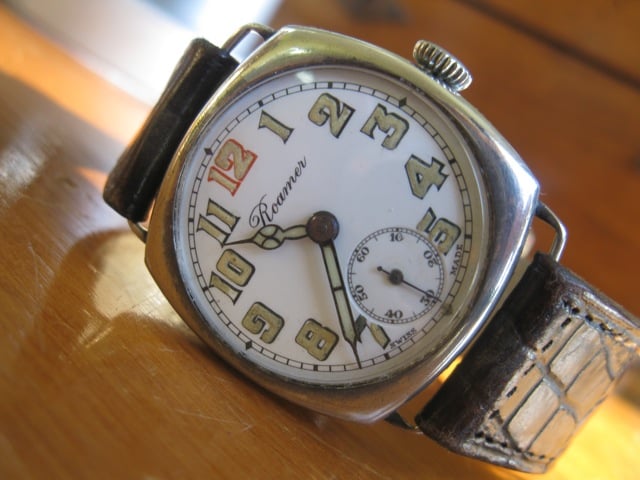
For example, Roamer began making their own cases because those previously supplied to them in through the 20s were made from chrome-plated brass that corroded easily. Roamer’s ongoing trajectory toward self-sufficient manufacture was not limited to cases, however—by the end of the 1930s, they were manufacturing their own dials.
In 1952, the company formed by the merger of MST and LTG finally cemented their company identity with their most successful product, changing their name to the ROAMER Watch Company, S.A.
The company had swelled to 1,200 employees. As Roamer decreased its dependence on external suppliers by enlarging the scope of their manufacture, they also shifted into the role of innovative leaders in the technical aspects of the industry; they developed dust and water resistant cases, and patented service procedures for the care of their signature watches.
Roamer Vintage Watches: Iconic Lines
The golden era of Roamer vintage watches, similarly to quite a few other brands, arguably took place in the 60’s and 70’s.
Roamer Anfibio
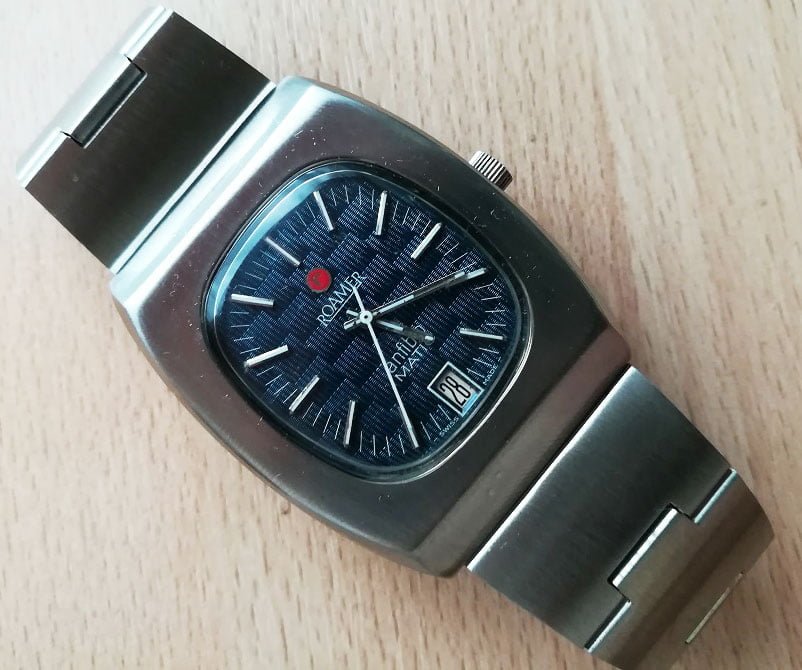
By the middle of the 1950s Roamer had patented their watertight case, leading to the launch of their Anfibio line, which gained world-renown for its reliable endurance and was a commercial success.
Roamer Mustang
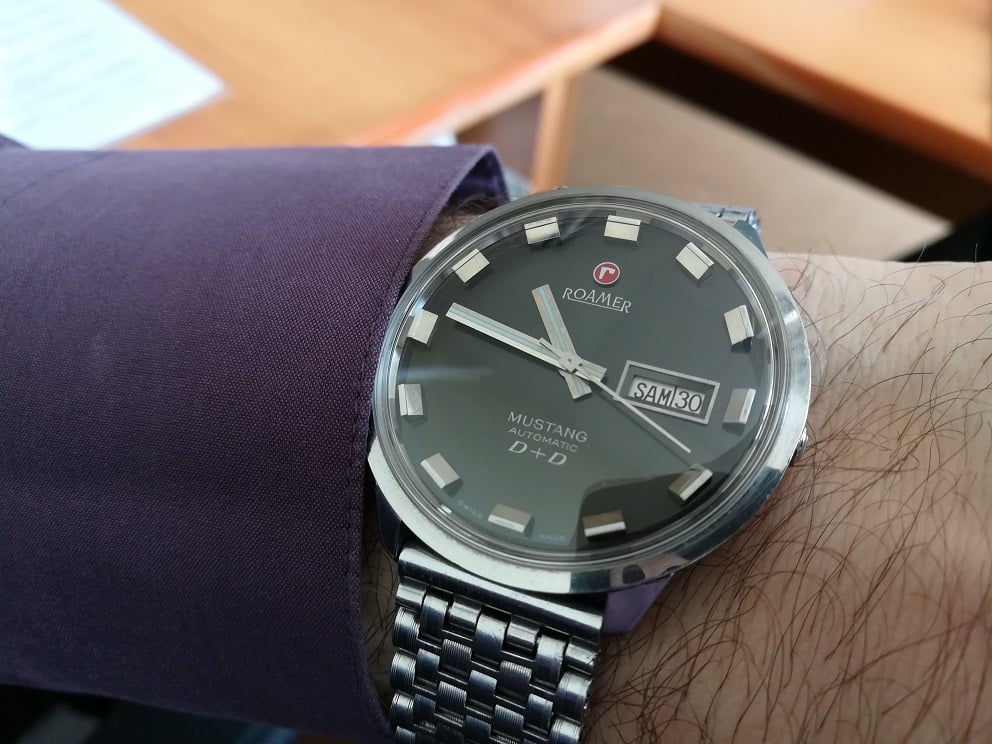
Mustang watches are closely linked to the racing heritage of the Roamer brand (the company sponsored Indianapolis race track, for instance).
Roamer Rockshell
Another famous line of watches is the Roamer Rockshell series, with loads of interesting and ambitious designs.
Roamer Stingray
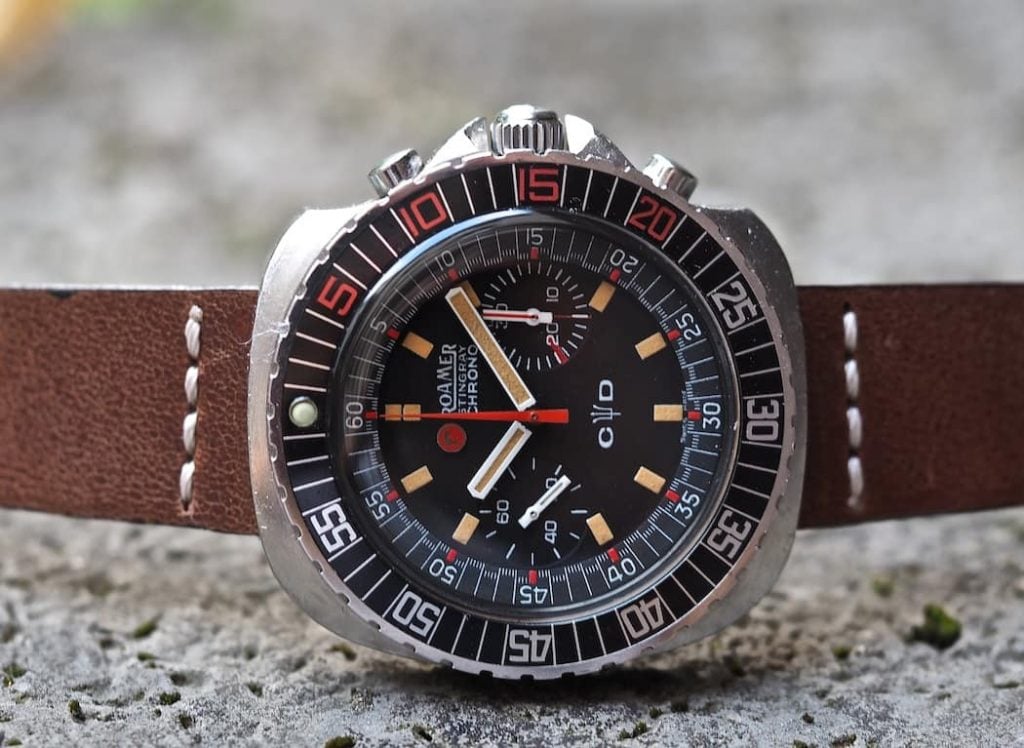
Stingrays were produced between 1966 and 1975 and were characterized by bold, sporty designs. The line included Stingray S diver watches and also Stingray Chrono, a beautiful chronograph powered by Valjoux 72 (there was also a funky-looking diver version of this chrono as pictured above).
The effects of the quartz era
Roamer introduced its first quartz timepiece to the world with the Micro Quartz. Though the watch has been viewed by some critics as one of the first inexpensive quartz watches accessible to consumers, it has been pointed out that the watch also shows high grade mechanical craftsmanship.
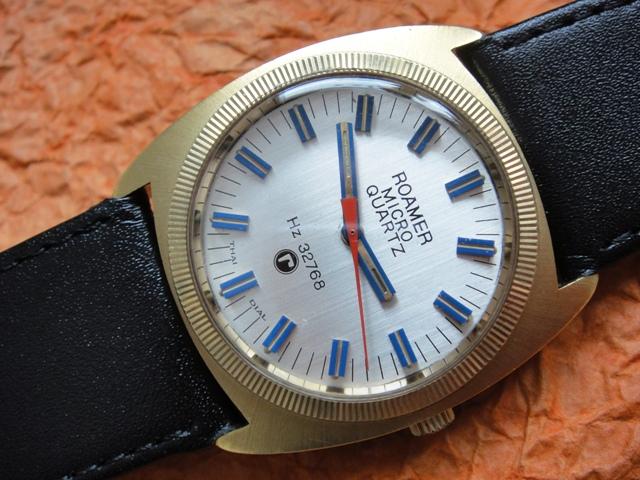
At a time when technical innovations and consumer demand were shifting watch production from Europe to Asian companies like Seiko, Casio, and Citizen (popularly termed the “quartz crisis”) Roamer made smart business decisions to avoid getting left behind, and instead found a happy medium between accessibility and quality.
The august watch face of the Micro Quartz, with bold blue lines and an almost art-deco feel, was a true collaborative effort between the old world craftsmanship of Swiss watchmakers and the cutting edge electronics of the United States; RCA manufactured the chip.
Roamer did not rest their laurels on the Micro Quartz alone, but manufactured other quartz pieces like diver’s watches and chronographs throughout the 1970s.
Restructuring to stay afloat
Unfortunately the Swiss watchmaking industry as a whole was hit hard by the popular transition from mechanical to quartz timepieces. Even Roamer was not impervious to the shifting winds of the global market, and in 1975 they severely downsized, closing its manufacture and laying off almost 50% of its workforce.
Roamer’s financial restructuring allowed them to move away from complete manufacture and focus on assembly and sales, but even with trimming the proverbial fat they could not keep up with competitors; they were granted a “restructuring moratorium” to assist in paying back their creditors (it’s a nicer way of saying bankruptcy).
By the end of the 1970s, Roamer was able to pull itself out of debt by selling off large amounts of stock, including a reported 60% to a Kuwaiti investor. By this time, Roamer was no longer a family company (Fritz Meyer’s sons Max and Ernst had both died in the late 60s). They were also no longer manufacturing their watches from start to finish, but rather obtaining parts from other suppliers (some decidedly not Swiss) and focusing on assembly.
ROAMER today: a brand facing mixed reviews
In 2003, Roamer made an iconoclastic decision to return to their roots and being manufacturing mechanical watches once again, especially with their Competence Collection. By 2010, Roamer was asserting itself as one of the most excellent Swiss watch brands in the medium price range. In celebration of their 125th anniversary, they launched a limited edition of the Stingray Chrono Diver Watch.

Through the various stages of company growth over the last 131 years, two attributes that have stayed consistent are their water-resistant, stainless steel cases, and scratch-resistant mineral crystals. The hard work they put into decades of developing their own manufacture have certainly paid off, resulting in a mid-priced watch company with a reputation for sterling quality—among some critics. Others view Roamer as a brand totally unrelated to the company that Fritz Meyer founded.
Indeed that would make sense. A bankruptcy and the shift from family-owned to corporate status would be enough to assess a business as one that has changed more than its face—but add to that the fact that Roamer shifted away from the self-sufficiency the Meyer family built, and replaced it with outsourcing the manufacture of their watch parts… what could one say other than the “magic” is gone (though the watches are still decent enough).
Something for (almost) everybody
But aside from the debate about how the continuity of a brand name affects their authenticity, one of Roamer’s strong points is that their brand is not confined to a single demographic of consumers. Browsing the collection on their official website, you will see a wide range of timepieces that can appeal to every taste and need.
From sports watches to celebratory, formal-looking chronographs, the designers at Roamer have left no stone unturned in their quest to provide consumers—both men and women—with (seemingly) excellent timepieces.
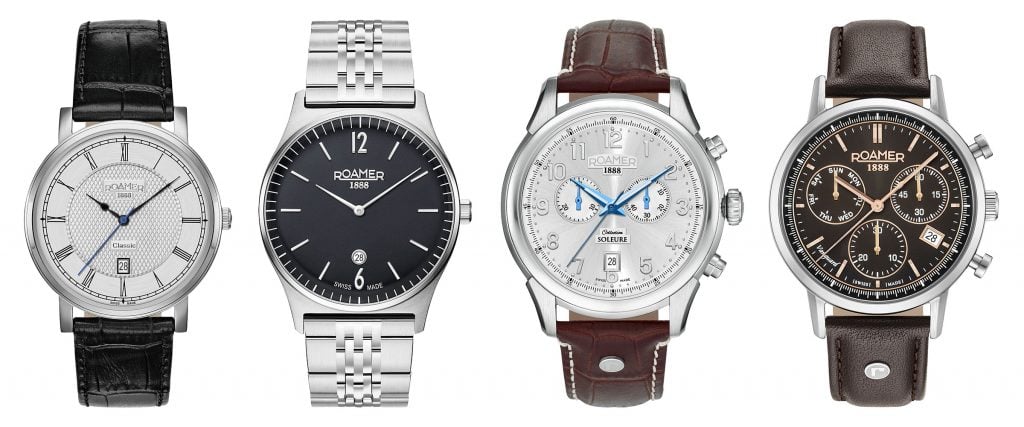
The materials and textures or Roamer watches come in a sizeable variety, appealing to almost anyone searching for watches both contemporary to the traditional. Bands are fashioned in leather, brass, stainless steel, rubber, and even velcro. The cases and faces are finished in gold and silver, with both flat matte and luminescent, polished textures—cast into a number of aesthetically pleasing shapes.
As for Meyer and Studeli, the founders of this brand, not much else is accorded to their respective biographies. Meyer is believed to have died around 1926, before the Second World War. He never saw his brainchild grow into the brand it is today, which (though it faces some mixed reviews by purists) is touted by some experts as a quality company that still flies somewhat under the radar.
Further reading : learn more about other prominent watch brands
References
- roamer-watches.info
- mirius.co.uk
- roamer.ch (official website)
Vintage Watch Inc
Dennis is the founder and editor of Vintage Watch Inc. Passionate about Soviet and Japanese vintage timepieces and a finance professional by day, he proudly wears a Seiko Pogue with his suit.

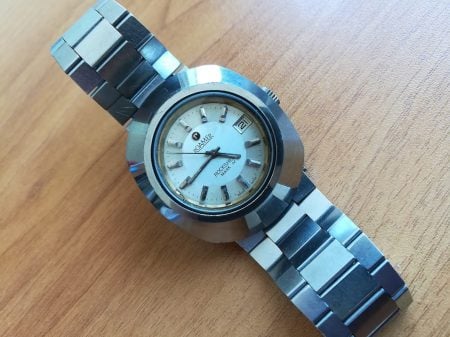
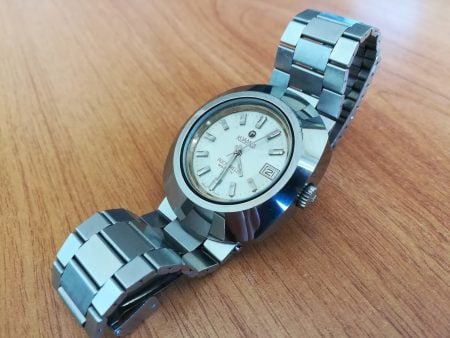
I write to ask if you could help me please, I have my grandfather old watch and I am trying to find out about it. The name of the watch is: “Roamer Swis Made Brevete” on the face are the words “Super-Shock 17 Jewels…
As well as, “RW ” with the word ROAMER under the two letters.
On the rear of the watch are the numbers, 305-467-305-776 it also has a second long number on as well.
I would love to know if you could help in any way.
Thank you and look forward to hearing from you.
Ron
Thank you for your comment. This looks like a Roamer Type II case as it has four patent numbers (“brevet” is patent in French). I’d guess this watch was made in the 50’s or early 60’s. Would be interesting to see the movement (calibre #372?). In terms of value, I’d say around $150. Hope this helps!
Thank you very much for taking the time to find out information about my grandfather’s watch very interesting to read. As for the inner workings. The value is of no interest to me (but nice to know) I will be getting a new strap for it and may well wear it from time to time. It does still work very well. Thank you again for all your work.
I have a very similar Roamer, and it dates to 1956 or 1957. I think the “crown” logo on the dial was removed in 1958 following legal action by Rolex, and the numbers on the caseback are Swiss patents awarded in 1955. Thus the watch is after 1955 but before 1958. The style (e.g. the “dauphine” style hands) is also typical of the 1950s. Others may have more expert knowledge.
Enjoy wearing this nice watch. Vintage Roamers are much underrated in the market, in my view.
–Hi, I’m trying to identify my Roamer watch, please, any help would be much appreciated!–It had a crystal replaced, but was not exact fit, so the dial jiggles a tiny bit whenever i move my wrist (watchmaker said no worries on harming the watch with that, still…)–still, i’d like to get an exact crystal proper fit, so it doesn’t do that–the sound annoys me and also psychologically it just doesn’t set right with me–I worry it will wear at the dial or something, even though I was told it wouldn’t –the sound is that of something that is crudely done,… Read more »
This watch looks like MST 413.
Recently found this anfibio matic at a yard sale , could you please supply a little more information on it …
Calibre MST 485, equivalent to ETA 2671. Some additional information on a similar watch at Ranfft.
Hi, I am trying to identify the model of an automatic Roamer Watch, more specifically, my late father’s. I don’t know how to upload pictures, so I have found one online which looks the same, except that it is silver, not gold coloured like the one in the picture: It says Automatic 50 m on the front and the numbers are from 13 to 24 instead of 1 to 12. It does not have the swiss cross on the back like some of the roamers shown here.. Is there any way to identify the model and estimate when he might… Read more »